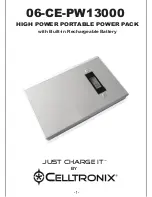
2-12
BOP HIPWR 091719
2.5.5
LOAD CONNECTION - GENERAL
Load connections require wires that are properly rated for the nominal output current of the unit.
Load connections to the BOP power supply are achieved via the OUTPUT and COMMON bus
bar-type terminals located on the rear panel. A barrier strip is provided at the rear panel for con-
nection of the sense wires to the load (for remote sensing or multiple unit applications). See
PAR. 2.5.3.1 and Figure 2-2 for earth-ground recommendations.
CAUTION: Never connect the load to the sense terminals. Monitoring instruments (e.g.,
DVM, etc.) are the only external equipment that may be safely connected to
the sense terminals.
CAUTION: Never connect the both the load terminal tied to the BOP COM terminal and
the programming device common to earth-ground. This allows a ground
loop current to flow within the BOP which will compromise accuracy. Cata-
strophic damage to the BOP will result if the connection between BOP COM
and the load terminal connected to earth-ground is lost.
NOTE
REGARDLESS OF OUTPUT CONFIGURATION, EITHER LOCAL OR REMOTE OUT-
PUT SENSE LINES MUST BE CONNECTED FOR OPERATION.
1. OBSERVE POLARITIES: The
OUT S
sensing wire must be connected to the
OUT-
PUT
load wire, and the
COM S
sensing wire must be connected to the
COMMON
load
wire.
2. IF LOCAL SENSING IS USED, INSTALL LINKS (see Figure 2-3).
CAUTION: The safety features incorporated into the BOP to handle energy from Active
loads are unable to protect the power supply or the load if input power to the
BOP is lost or if the BOP malfunctions. It is recommended that the user mon-
itor “Power OK” flag pins 3 and 4 of the external Protect Port (see Table 2-4)
and implement a fast-acting means of disconnecting capacitive loads or
crowbarring inductive loads to prevent damage to both the BOP and the load
in the event of input power loss.
2.5.6
LOAD CONNECTION USING LOCAL SENSING
Figure 2-3 shows a typical configuration using local sensing and a grounded load; for local
sensing with an isolated (“floating”) load, do not install the ground connection (see Figure 2-3,
Note 2).
2.5.7
LOAD CONNECTION USING REMOTE SENSING
Figure 2-4 shows a typical configuration using remote sensing and a grounded load; for remote
sensing with an isolated (“floating”) load, do not install the ground connection (see Figure. 2-4,
Note 2).
Use #22 AWG wire, twisted pair for remote sense connections.
2.6
COOLING
The power devices used within the power supply are maintained within their operating tempera-
ture range by means of internal heat sink assemblies and by two cooling fans. Periodic cleaning
of the power supply interior is recommended. If the power supply is located within a confined
space, take care that the ambient temperature, which is the temperature of the air immediately
surrounding the power supply, does not rise above the specified limits (see Table 1-2).
Содержание BOP-ME 1KW
Страница 2: ......
Страница 20: ...xii BOP 1K 091719 FIGURE 1 1 HIGH POWER BOP SERIES POWER SUPPLY...
Страница 42: ......
Страница 64: ...2 22 BOP HIPWR 091719 FIGURE 2 11 PARALLEL CONFIGURATION LOCAL SENSING TYPICAL...
Страница 65: ...BOP HIPWR 091719 2 23 FIGURE 2 12 PARALLEL CONFIGURATION REMOTE SENSING TYPICAL...
Страница 76: ......
Страница 161: ...BOP HIPWR 091719 3 85 FIGURE 3 29 STATUS REPORTING STRUCTURE...
Страница 164: ......
















































